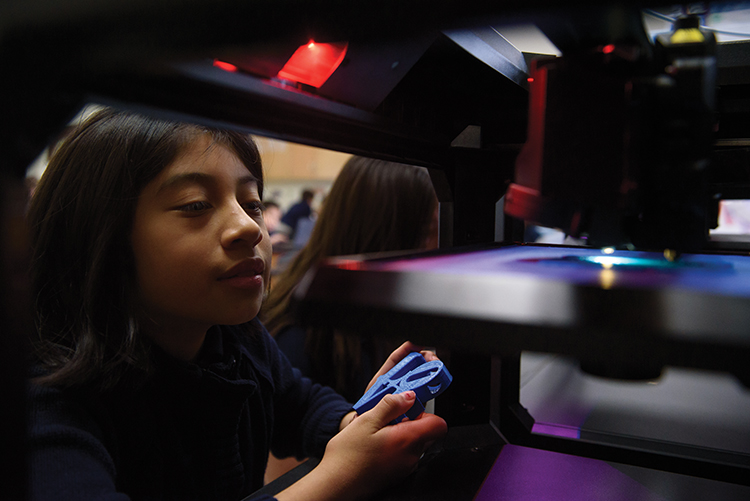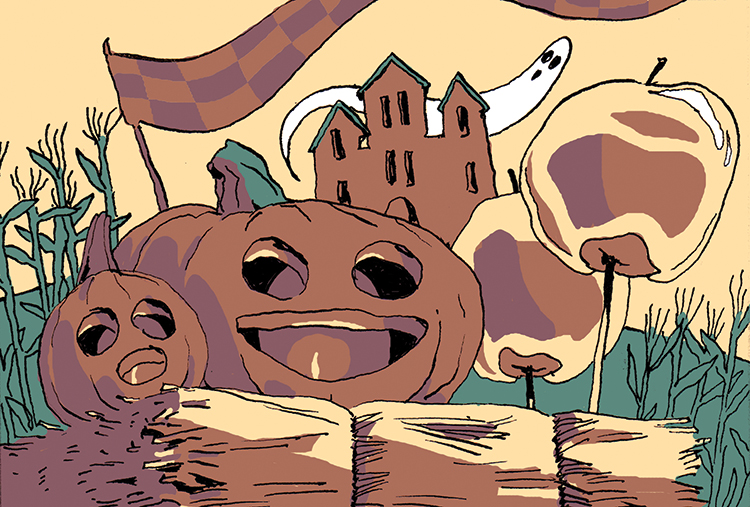Illustration by Chris Bernhardt
Insider Art
interview by Heather Shayne Blakeslee
Museum activist Nina Simon is an electrical engineer by training who hails from Los Angeles—she now runs the Santa Cruz Museum of Art & History in California. Her own outsider status when it came to the hallowed halls of an art gallery is one of the reasons she is full of hard questions about who these institutions really belong to, and what they are capable of.
In her book “The Art of Relevance,” she challenges her colleagues—whether they’re from a small community group or a large institution—to ask themselves: Who can see your front door? Who feels comfortable walking through? Do they see themselves reflected in what’s inside? What is lost when people are kept out by the people already inside?
Many people have written extensively on why the humanities matter to democracy. What role do you think the humanities play?
NS: I’d say we are only as relevant as people say we are. People in the humanities or the arts or history, we can’t proclaim by fiat, “Hey, people need us more than ever right now.” We can say it, but people decide for themselves what they think is relevant, what they think they need, what they think they want.
So I think it behooves us right now not to rest on making arguments for the value or the importance of the humanities or of arts, but to demonstrate the value and to demonstrate the relevance and meaning to people who are looking for connection, who are looking to belong, who are looking to be part of building a stronger and more resilient community and more resilient society—then people will tell us that we have been meaningful to them.
You talk in the book about former first lady Michelle Obama’s address at the reopening of New York’s Whitney Museum of Art in 2014. She said, “There are so many kids in this country who look at places like museums and concert halls and other cultural centers, and they think to themselves, ‘Well, that’s not a place for me, for someone who looks like me, for someone who comes from my neighborhood.’” How does our country change when those institutions are made relevant and open to those young people? What does it look like?
NS: It looks like institutions of elitism, privilege and oppression becoming institutions that are owned, used and loved by a greater diversity of people. That’s not to say that any particular institution that currently exists is oppressive, but that traditionally these institutions—and obviously, I work for museums, but this is also true for theaters and symphony halls—are and were instruments of elitism and instruments of the separation of classes in our country. If we open those up, we help break down some of those divisions that are so prevalent in our society today.
You use yourself as an example of the ultimate user and insider when it comes to the National Park Service—you write that you feel welcome to the point of being self-critically entitled to the experiences you want. How can insiders at organizations actually keep others out?
NS: Well, we do it all the time, because any place where you’re an insider, the reason you’re an insider is because you feel so comfortable there. And so, the things that make you feel comfortable might make other people feel uncomfortable—but you are completely unwilling for them to change… [Imagine preferring] a gym where they play heavy metal, and, “Ugh, if they went to techno, the place would be ruined.”
We’re insiders because we feel that that place is for us. We feel that it connects to our identity and who we are. So we expect that other people—if they choose to come into that place—should come in the same way we did, and on our terms.
This happens all the time in museums and in arts institutions, that well-meaning insiders will say, “Yeah, we want different kinds of people to come in, but we want them to come in for the reasons we came in. We don’t want them to come in for something else.” That argument gets used to do things like, say, “Video games aren’t appropriate in libraries because we come to libraries for books.” Or, “Tweeting isn’t appropriate at the symphony because I come to the symphony to have an experience that is just me and the music.” I think there are things that insiders like and become accustomed to—and then they make them into rules that make other people feel uncomfortable.
What are some organizations that you think are doing a particularly good job of opening up?
NS: The International Coalition of Sites of Conscience, which is a consortium of many historic sites and museums—places like Tenement Museum in New York or the Eastern State Penitentiary [in Philadelphia]. The fact that [Eastern State Penitentiary decided to shift from] an educational entertainment venue [to hosting] opportunities for real dialog about the impact of mass incarceration—that’s extraordinary and courageous. The Barnes is opening up conversations about, “How do we shift from a very insider-branded organization to one that is for this whole city?” I think that’s powerful.
And then there are organizations that are rooted in communities of color that are saying, “Hey, we’ve been doing this work all along,” and I just can’t say enough about organizations like Laundromat Project in New York, or the [Wing Luke Museum of the Asian Pacific American Experience] in Seattle—organizations that are rooted in communities that have been trying to bridge and to connect insiders and outsiders. I think their work is incredibly important, and I think any organization that takes this moment as a moment to go there and to say, “We’re not just relevant because we have great art or because we tell important stories or because we have historical objects that matter, but we’re using those things to invite people into a conversation, into a roomful of meaning that is going to change the conversation in our city.” I think anybody who’s doing that, hats off to them.
Philadelphia is a city with sustainability baked into its design and current culture. But more and more we talk about that in regard to resilient communities and neighborhoods where people know and care for each other. In what ways are places with vibrant cultural organizations that foster community more resilient than others?
NS: I work with other professionals in my community who are working with people transitioning out of the prison system, or homeless adults with health issues. And they are dealing so much every day with life-or-death situations at their front door. Art is not going to solve this problem—it’s not going to end homelessness, it’s not going to fix the prison system—but it can open a side door into that conversation for a lot more people to care, connect and to take action around these issues. So I think there’s a huge role for arts organizations to play, not just in being welcoming, but really in being part of action and conversation that make our communities more resilient and more sustainable, more equitable.
[We can’t start with the idea that], “We in arts organizations have something to sell you or something to bring to you or something to give you.” Instead [we should be] saying, “Let’s talk with people in the communities we care about. What are the issues and questions? The dreams?” And then, “How can we commission, connect, bring, create art that is responsive and invites more around that?”
In Philadelphia, Temple Contemporary, which is an arts organization that really works with people to create art projects that open up new conversations about intractable issues, they were working with community members around issues of gentrification and dislocation and created “Funeral for a Home.”
At our museum in Santa Cruz, we’re doing a lot of projects that start with community conversations. We feel like our job is not to be the institution that has the art and delivers it up, but instead to be the institution that invites people to go further around those issues, dreams, ideas that are already urgent and compelling in their world.
Given the current state of our country, what are you most hopeful about?
NS: People are using this term “woke”—which came out of the world of African-American activism but has become more broad—I think there is this sense of people having an activated desire to engage themselves. I think we watched the national election happen as theater for so long, and then when that play did not end the way some people expected—many people expected—we realized, “Wow, we were passive consumers of this story. Let’s become agents of the next chapter of the story instead.”
I’m excited about people’s energy for action, and I’m really excited about the unique role—I believe—that arts organizations can play in building those bridges and being locusses that invite creative action at a time when people are hungry to do that.
Nina Simon is the executive director of the Santa Cruz Museum of Art and History, and the author of “The Art of Relevance.”






Driving change with interdepartmental collaboration by working with multiple teams managing communities.